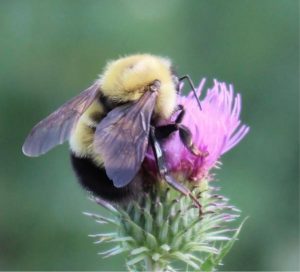Creating Habitat for Virginia’s Native Specialist Bees
By Brad Willet, Fairfax Master Gardener

Bombus perplexus
June celebrates National Pollinator Week (June 18 to 24) and among the variety of activities associated with local initiatives supporting pollinators, there are many things we can do in our own landscapes to support these key species. Flowers provide physical clues to their pollinators; sight, smell and design. Your plant choices will directly impact which native pollinator species will choose your landscape to make their home.
Virginia is host to countless pollinator species and roughly 400 different bee species alone. That’s a lot of buzzing, but all the buzzing depends greatly on the type of garden habitat you grow: what is in flower, temperature, time of day and presence of host plants. The variables can seem endless. The plants that will supply the amplest amount of necessary food are native plants that these insects have had an intimate relationship with for thousands of years.
Native plants, plants historically indigenous prior to European colonization, have the appropriate coloration, nectar source, flower type and pollen type for native pollinators to feed upon and provide the greatest benefit to native pollinators. Fairfax County is home to a significant number of native pollinators and native plants providing a wide range of habitat options.
Native bees are divided into two groups, generalists (about 80 percent) and specialists (about 20 percent). There are many generalist bees (typically the genus Bombus) who are able to feed their young with a wide range of plant family species within a range of 500 feet and 2 miles. According to a study done by Jarrod Fowler and Sam Droege, they found that of the roughly 450 bee species native to the Mid-Atlantic and Northeastern United States, about 100 species are native to Virginia. About 25 percent of those are pollen specialist bees and can only use pollen from a select group of plants or plant families. Despite abundant floral blooms provided in a landscape, these pollen specialists will have to pursue other forage areas to access crucial pollen-producing host plants necessary for their survival. By cultivating groupings of these particular host plants for specialist bees, you are likely to provide a hospitable habitat for not only specialist bees, but many generalist bees or other pollinators.
Some of the specialist bees likely to be found in Fairfax County are:
- Andrenidae (mining bees).

Andrena sp.
This bee family carries a wide variety of coloration, sizes and specific dietary preferences. All of these solitary bees nest in the earth, hence “mining bee,” from 1 inch to 1 foot or more beneath the surface. They will line their nests with a waterproof substance, which may even withstand water of seasonal lakes. They are cold hardy making them one of the earliest species to emerge as spring flowers are beginning to bloom, well before honeybees (Apis mellifera). Typically active during the spring, some will also emerge in early summer or even fall when flowers are blooming. Females will appear to have pollen “sacs” on their hind legs and are pollen specialists mostly of the Asteraceae family. Males are not picky about pollen attributes and will visit a wide range of flowering plants with a range of around 500 feet. Specifically, female mining bees will forage on springbeauty (Claytonia virginica), goldenrods (Solidago spp.), asters (Symphyotrichum spp.) willows (Salix) and golden alexanders (Zizia aurea). These specialist interactions help provide necessary proteins for developing larvae. Some studies indicate the specific pollen grains contain scented volatile oils that help newly emerged bees to find the appropriate plant species on which to forage. All of these bee species have short tongues, so they seek out plants that have shallow flowers.
- Colletidae (plaster bees).

Colletidae-Colletes Cellophane bee
This diverse group of small-sized, short-tongued bees with members are hairless, loud buzzing or nocturnal. Most of these specialist species can only forage on specific host plant species within a 500-ft range between nest sites and host plants. However, even the generalists habitually forage on one flower species. The bees in this family are solitary and make nests in a variety of cavities, ground tunnels or twigs and hollow stems, and use a “cellophane” type of substance to line their nest walls, hence the nickname “plaster bee”. These bees tend to nest in the same area over successive years, and while solitary, nesting sites may form aggregations of multiple bees during a brood season. They provide their young a “soupy” mixture of pollen, nectar and water instead of a “ball” of pollen for food. Bees of this family are commonly found in Virginia during the late summer to fall specializing mainly on flowers of the Asteraceae family–specifically goldenrod (Solidago spp.) and asters (Symphyotrichum spp.).
With the wide variety of plant choices out there, each gardener can create a space that not only provides continual seasonal enjoyment but also can provide for a variety of habitat needs of pollinators. Native plants can provide a more complete habitat beneficial to our many varied garden visitors. While the old adage of “right plant, right place” plays into this, there are choices that can be made in a well-planned habitat in your landscape that provide significant pollen and nectar choices for pollinators, especially crucial for specialist species. Selecting a few native plants that play host to these special pollinators will not only ensure their continued survival but will also help to bring generalist species as well.
References
• Conserving Bumblebees, Xerces.org. (2012).
• Attracting Pollinators to Your Garden Using Native Plants, US. Department of Agriculture (USDA)
• Specialist bees of the Mid-Atlantic and Northeastern United States, Jarrod Fowler & Sam Droege
• Pollinators of Native Plants, H. Holm, Minnetonka: Pollination Press LLC
• Pollen mixing in pollen generalist solitary bees, Michael Eckhardt et al, Journal of Animal Ecology
• The importance of pollen chemistry in evolutionary host shifts of bees, Maryse Vanderplanck, et al,
nature.com
• The Bees in Your Backyard, J. Wilson, Princeton: Princeton University Press
… updated 2022